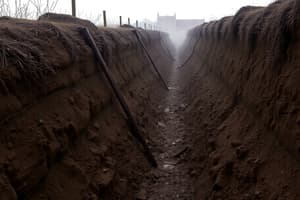Podcast
Questions and Answers
Which of the following scenarios BEST exemplifies the complex interplay of militarism, alliances, imperialism, and nationalism (M.A.I.N.) as a cause of World War I?
Which of the following scenarios BEST exemplifies the complex interplay of militarism, alliances, imperialism, and nationalism (M.A.I.N.) as a cause of World War I?
- Canada's participation in key battles such as Ypres, the Somme, Vimy Ridge, and Passchendaele, demonstrating its commitment to the British Empire.
- The introduction of new technologies such as tanks, poison gas, and machine guns, which dramatically changed the nature of warfare.
- Austria-Hungary's declaration of war on Serbia after the assassination of Archduke Franz Ferdinand, triggering a chain reaction of alliance obligations. (correct)
- The construction of trenches along the Western Front, leading to a prolonged stalemate and immense casualties.
The Schlieffen Plan aimed to:
The Schlieffen Plan aimed to:
- Establish defensive positions along the Rhine River.
- Secure naval dominance in the Atlantic.
- Defeat Russia quickly before turning to France.
- Avoid fighting on two fronts by quickly defeating France before Russia could fully mobilize, and invading France through Belgium (correct)
The conditions in the trenches on the Western Front were generally sanitary and resulted in minimal casualties due to disease.
The conditions in the trenches on the Western Front were generally sanitary and resulted in minimal casualties due to disease.
False (B)
Explain how new technologies employed during World War I contributed to the unprecedented scale of casualties and the nature of trench warfare.
Explain how new technologies employed during World War I contributed to the unprecedented scale of casualties and the nature of trench warfare.
The term ________ refers to the psychological distress experienced by soldiers exposed to prolonged combat and heavy artillery bombardment.
The term ________ refers to the psychological distress experienced by soldiers exposed to prolonged combat and heavy artillery bombardment.
Match the following battles with their significance in Canadian military history during World War I:
Match the following battles with their significance in Canadian military history during World War I:
Which statement BEST describes the reasons why diverse groups of Canadians (including Indigenous, Black Canadians, women, and Chinese/Japanese Canadians) chose to enlist during World War I?
Which statement BEST describes the reasons why diverse groups of Canadians (including Indigenous, Black Canadians, women, and Chinese/Japanese Canadians) chose to enlist during World War I?
Which of the following arguments would a conscientious objector MOST likely use to justify their opposition to World War I?
Which of the following arguments would a conscientious objector MOST likely use to justify their opposition to World War I?
The conscription crisis in Canada during World War I had widespread support in Quebec due to a strong sense of national unity and shared sacrifice.
The conscription crisis in Canada during World War I had widespread support in Quebec due to a strong sense of national unity and shared sacrifice.
Explain how the internment of 'enemy aliens' in Canada during World War I reflects the complex relationship between national security concerns, xenophobia, and the violation of civil liberties.
Explain how the internment of 'enemy aliens' in Canada during World War I reflects the complex relationship between national security concerns, xenophobia, and the violation of civil liberties.
Flashcards
Militarism
Militarism
A policy of glorifying military power and keeping a standing army always prepared for war.
Alliance
Alliance
A union or association formed for mutual benefit, especially between countries or organizations.
Imperialism
Imperialism
A policy of extending a country's power and influence through colonization, use of military force, or other means.
Nationalism
Nationalism
Signup and view all the flashcards
Assassination
Assassination
Signup and view all the flashcards
Schlieffen Plan
Schlieffen Plan
Signup and view all the flashcards
Stalemate
Stalemate
Signup and view all the flashcards
No Man's Land
No Man's Land
Signup and view all the flashcards
Conscription
Conscription
Signup and view all the flashcards
Enemy Alien
Enemy Alien
Signup and view all the flashcards
Study Notes
- Key people and places in WWI: Archduke Franz Ferdinand, Gavrilo Princip, Austria-Hungary, Germany, United Kingdom, France, and Serbia
Causes of WWI
- M.A.I.N. causes of WWI encompasses militarism, alliances, imperialism, and nationalism.
- The assassination of Archduke Franz Ferdinand was another cause of WWI
- Key alliances included the Triple Entente and the Triple Alliance.
Fighting on Land, Sea, Air
- Summer of 1914 marked the beginning of the war.
- The Schlieffen Plan was implemented.
- Germany invaded France through Belgium.
- The Western Front was a significant theater of battle.
- Stalemate resulted in trenches.
- Trench conditions led to huge casualties.
- Tanks, poison gas, machine guns, aircraft, and submarines as new technologies in the war.
WWI Canadian Battles
- John McCrae and Sir Arthur Currie were key figures
- Key Canadian battles included the Battle of Ypres, the Battle of the Somme, the Battle of Vimy Ridge, and the Battle of Passchendaele.
Recruitment
- Canadians volunteered from diverse backgrounds, mainly young working-class individuals.
- Indigenous, Black Canadians, Women, Chinese and Japanese Canadians also volunteered.
- Canadians of different backgrounds fought in WWI for various reasons.
Opposition To the War
- People opposed the war for various reasons.
- Those who opposed the war faced mistreatment.
- Some reasons for opposing the war were more convincing than others.
Canadian Homefront
- The war economy was a major factor on the homefront.
- The conscription crisis led to Quebec Anti-Conscription Protests and Riots in 1918.
- "Enemy Aliens" were placed in Internment Camps from 1914-1918.
Studying That Suits You
Use AI to generate personalized quizzes and flashcards to suit your learning preferences.




